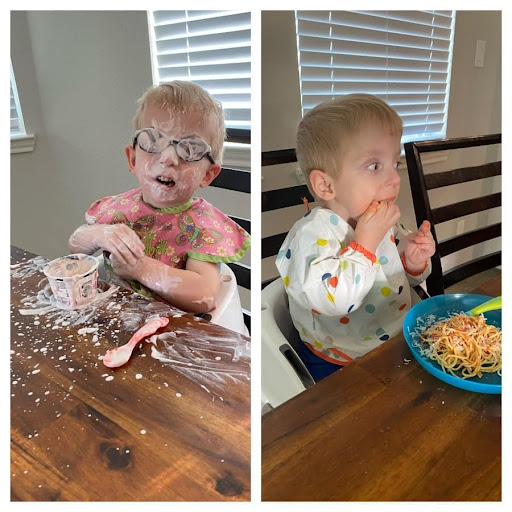You’re making a mess!
Why it is important to allow mess when learning to eat
Crumbs on the floor, yogurt on the wall, pancakes on the ceiling, flour through the hair…. Okay, it may not quite be that extreme but yes, I understand that mess, is mess, is mess.
This blog is based on my favorite quote ever, “It’s hard to be neat when you’re learning to eat”.
The easiest way for a child (anyone for that matter) to learn something new is to practice, explore and immerse themselves in the task. The same is true for feeding. We learn about food through exploring with our whole body, this means that mess is inevitable. When we are not able to learn about food this way, we quickly learn that food is something to be afraid of because it feels foreign to you. It also meets the needs of our sensory system which learns about the texture, smell, sight, and taste of food during this exploration time.
The predominant system at play here is our sensory system.
We are continuously receiving and interpreting sensory information from our environment and internally. We receive this information through our 8 senses:
- Touch (receptors found in our skin)
- Smell
- Sound/hearing
- Sight/vision
- Taste
- Vestibular (receptors found in the inner ear that control our balance)
- Proprioception (receptors found in our muscles and joints that control our awareness of our body in space)
- Interoception (our internal recognition of hunger, fullness, thirst, bowel, and bladder motions)
Everyone’s body responds to information from the environment differently. For example, one person may become distressed in busy noisy environments where another person may thrive. This refers to our individual sensory cups.
If you were to picture your body as a cup, with the water inside the cup being your regulation level and ability to concentrate, engage and respond to the environment. Some of us require a large amount of sensory input to maintain regulation. For others, it takes very little input for the water level in their cup to fill and often overflow. If we think of a busy noisy environment example, someone who needs lots of input to maintain their regulation level is likely to stay in these environments for longer than someone where it takes little to no input for their water levels to fill and overflow, causing them to distress and dysregulate quickly.

Image: greatkidsplace.com
Food holds its own sensory properties which can contribute to a child’s water level filling and overflowing. It is important to take time to understand your own and your child’s unique sensory processing needs in order to understand what and how much input is needed to maintain the water level of their cup.
Why is it important for children to be messy when they are eating?
- Children explore the world through their hands and mouth. They need to immerse themselves in the feeling and texture to know that it is safe to explore further.
- The receptors on our hands are the same receptors that are found in our mouth, so by touching food with our hands, we are preparing our mouth for what the food will taste like.
- Children that are cleaned constantly begin to learn that food and mess is not okay, becoming distressed whenever they get messy and avoid foods that may create a mess.
Children learn through exploring, in relation to food they need to touch food with their hands and tolerate the mess of food on their hands for the duration of the meal. When food is wiped from their hands or face throughout the meal, this firstly disrupts their eating patterns, and secondly reinforces to the child that being messy is not okay and that this food is not safe, we must get it off your hands.
Some children’s sensory systems can find the touch of food on their hands overwhelming and distressing. In these situations, you can have a cloth close to the child, only for them to use in their own time and when they feel it is necessary.
For caregivers who are struggling with the mess, remember the mess is good and can always be cleaned up, make sure bath time comes after dinner, have outdoor playtime after meals, and remember in the long term, you are helping to create happy, healthy, positive eaters.
In summary
- Children need to be messy with eating, as crucial for their sensory system and mouth to learn and tolerate what the textures feel like.
- Save wiping a child clean until after the meal, not during the meal.
- “It’s hard to be neat when you’re learning to eat”
Rebecca Barnard

